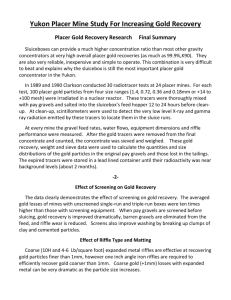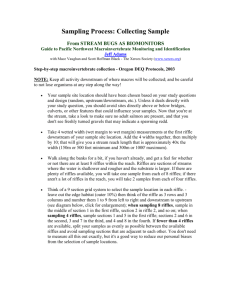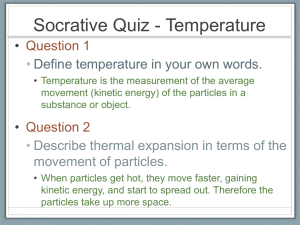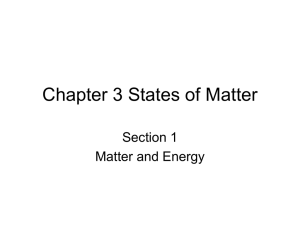Optimization of Sluice box Performance
advertisement
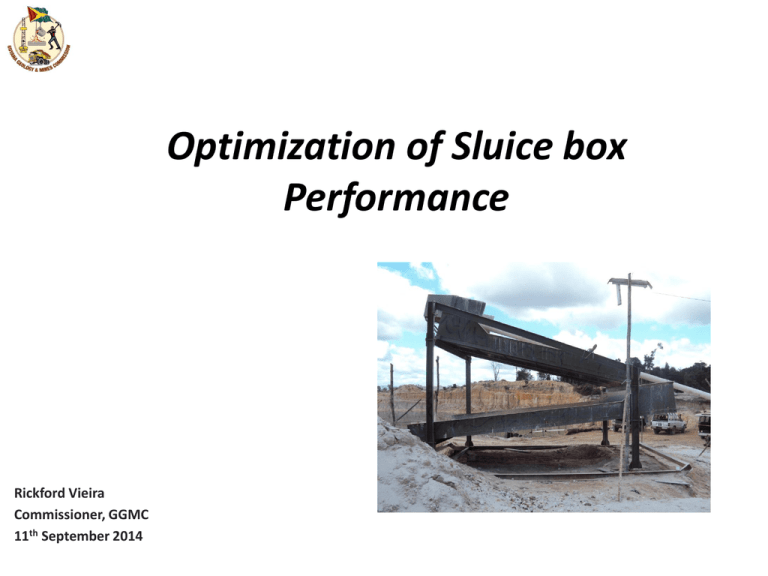
Optimization of Sluice box Performance Rickford Vieira Commissioner, GGMC 11th September 2014 Introduction A sluice-box is essentially a section of open sloping channel, with some form of riffling on the lower surface to collect the concentrate -fits into the category of deposit flowing concentrators Cross-sectional area has traditionally been considered to be a balance between two opposing considerations. For a given fluid flow: -A wider sluice-box produces a thinner film of water and is thus more amenable to recovery of finer heavy minerals; and -A narrower channel has a deeper flow and is more suited for recovering larger particles and transporting course gangue along the sluice-box. Sluice-boxes are always set at an inclination, the slope of which is again a balance between conflicting factors, similar to those that determine width. A number of types of riffles have been used and includes, longitudinal riffles, blankets, mercury traps, “hungarian” or “dredge” riffles and expanded metal. Description of the Sluice-box The sluice-box is essentially a section of open sloping channel, with some form of riffling on the lower surface to collect the concentrate. A combination sluice-box with three sections were developed for this investigation Advantages/Disadvantages • Advantages: • • • • • • • • - very low cost - high capacity (alluvial mining) - local production - no motor no moving parts - easy operation - good recovery even for fine gold (if properly built and operated) - high enrichment ratio - good for cleaning of amalgamation tailings • Disadvantages: • - needs much manual work, security problem • - discontinuous process ANALYSIS OF PERFORMANCE The feed grade (material that was processed) was usually so low that no reliable measure of recovery was possible. Further, the tailings grade was not of much concern. Each section of the sluice operated with relatively fixed cycle time that was based on the riffle packing criteria. Sluiceboxes are primarily used for the treatment of alluvial material where the denser valuable mineral is usually highly liberated. Losses in the over or under-size particles tend to dominate the consideration of sluiceboxes Water flow rate and slope • • Some of the early work on sluiceboxes used criteria such as “water duty” to describe the flow rate. Longridge criteria was based on the velocity of water necessary to move gravel of the given size using; • 0.08 m/sec Begins to wear away fine clay • 0.16 m/sec Just lifts fine sand • 0.20 m/sec Carries sand as coarse as Bird seed • 0.23 m/sec Moves fine sand • 0.61 m/sec Moves pebbles 2.5 cm. in diameter • 1.02 m/sec Moves egg-sized pebbles • 1.63 m/sec Moves stones 7.5 -10 cm. in diameter • 2.03 m/se Moves boulders 15 – 20 cm in diameter • 3.05 m/sec Moves boulders 15 – 20 cm in diameter The sluicebox slope can then be determined from: G = C v2P 2A G= slope: v = velocity: P = Wetted perimeter; A = area filled by water and dirt; C = variable coefficient, depending on the friction character of the gravel. • Designing optimum alluvial gold recovery plants requires a detailed knowledge of the size, shape and surface physical characteristics of the gold particles and the host alluvium in the pay gravel, sand and clay • Particles down to 100µm could be recovered effectively once the throughput, the feed top size are reduced and the Corey Shape Factor (C.S.F) of the gold particles are greater than 0.4. Flow Rates From visual observances, three modes of particle transport due to flow rates were identified. At low flow rates, particles build up against the riffle until it becomes full, and then roll/slide into the next riffle spacing. At moderate flow rates, erosion by turbulence increases, and reduces the amount of material held in the riffle. At high rates most of the material is carried downstream, leaving only “dead zones” in the corner. Flows Turbulent flow Laminar flow MATTING. The Nomad (magic) matting was far more superior to the Brazilian matting. The former has more space to accommodate material and is easier to clean up. The Brazilian type needs to be cleaned more often and is only effective for the recovery fine gold particles Matting Carpet only” -sluice boxes: - little amount of preconcentrate - high enrichment - fast amalgamation - little amount of amalgamation tailings “Carpet only” -sluice box for fine gold: “Carpet only” -sluice box for fine gold: SURGING Breaks in the feed while maintaining the water flow have only caused a slight loss in recovery, while the gold particles migrated further along the sluice. However, surges due fluctuating slurry flow was found to be detrimental to the effective recovery of the finer size range. These surges tend to “flush out” the material that was trapped in the riffles CLAY Clay slimes have little effect on gold recovery under most condition. Sticker clays can formed clay balls that were transported out of the sluice-box with the tailings and some gold particles SCREENING Would allow a lower flow rate , shallower slope, and the effect of differences in specific gravity would be more pronounced due to the lower influence of particle sizes Screening CYCLE TIME The cycle time would vary from operation to operation. Standard practice seems to be for clean-up to carry out after the pit is finished Should be carried out when a significant portion of the riffles have been filled with (heavy) sands Clean-up Typical mass balance for the use of sluice-boxes • Feed: alluvial gold ore: 100m3 or 180t (one day) = 100% • Rougher sluice-box pre-concentrate: 180kg = 0.1% • Cleaner sluice-box concentrate: 18kg = 0.01% • Only the cleaner concentrate or 0.01% of the material is amalgamated! • 99.99% of the material is discharged completely free of mercury contamination • Cleaner sluice-box tailings are recycled to feed DISCUSSION Establishing the slope, plus water and solids feed rates to provide optimum scour behind the each riffle. Although, the research had difficulties maintaining uniform feed rates over long period of time, slurry rates between 250kg/m/min to 1400kg/m/min. By reducing the feed top size, the flow rate required to transport larger gangue particles out of the sluice could be effectively used to sort the minerals based on their specific gravity The Nomad matting proved to be a very effective gold trap to hold large amounts of gold and prevent its migration down the sluice. Clean-up periods should be designed to avoid the riffles from being packed which may lead to gold migration and possible losses. CONCLUSIONS There are four basic processes for the successful operation of the sluice-box. The gold particles must be delivered to the plane of the riffle surface. The rifles must be capable of attracting the gold particles in it’s storage. The riffles must hold the gold particle in preference to other minerals. The gangue must be transported out of sluice-box. The failure of any of these processes could reduce performance, and any operating or design strategy must consider all these factors, and by implication, their interaction.
